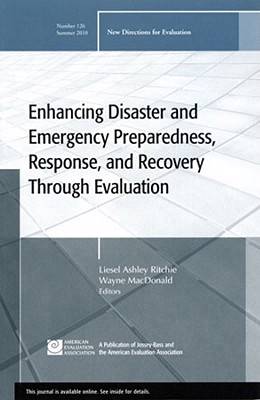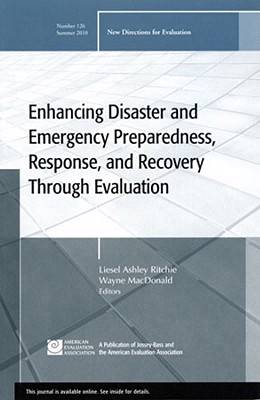
- Retrait gratuit dans votre magasin Club
- 7.000.000 titres dans notre catalogue
- Payer en toute sécurité
- Toujours un magasin près de chez vous
- Retrait gratuit dans votre magasin Club
- 7.000.0000 titres dans notre catalogue
- Payer en toute sécurité
- Toujours un magasin près de chez vous
Enhancing Disaster and Emergency Preparedness, Response, and Recovery Through Evaluation
New Directions for Evaluation, Number 126
Ev (Evaluation), Ev, Baker Sidney MacDonaldDescription
- systemic assessment of needs
- interagency coordiantion
- evaluation of responses in real time
- evaluation in international and national jurisdictions
Our humanitarian impulse, as in the aftermaths of the Rwandan genocide, Hurricane Katrina, the Indian Ocean tsunami, and the January 2010 earthquake in Haiti, is an enduring quality. The route from donor to affected population is long and varied. When sudden, unprecedented needs are juxtaposed with expectional levels of charitable responses, the question is whether the responses were good enough. Did supply meet demand? Was it the right thing? Was it done well? Who received support? Was it appropriate? Was the timing right? Can it be improved? All are questions for evaluation. For populations traumatized by disaster, the answers have consequences for protection, for restoration of individual and community efficacy, and ultimately for hope and dignity.
This is the 126th volume of the volume of the Jossey-Bass quarterly report series New Directions for Evaluation, an official publication of the American Evaluation Association.
Spécifications
Parties prenantes
- Auteur(s) :
- Editeur:
Contenu
- Nombre de pages :
- 128
- Langue:
- Anglais
- Collection :
- Tome:
- n° 126
Caractéristiques
- EAN:
- 9780470769126
- Date de parution :
- 12-08-10
- Format:
- Livre broché
- Format numérique:
- Trade paperback (VS)
- Dimensions :
- 150 mm x 224 mm
- Poids :
- 176 g

Les avis
Nous publions uniquement les avis qui respectent les conditions requises. Consultez nos conditions pour les avis.






